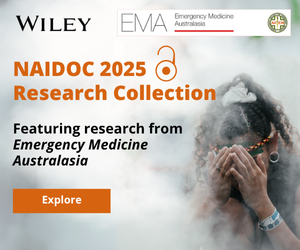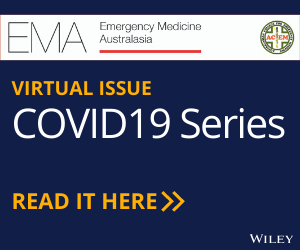Reviewer Guidelines
Thank you for your willingness to assist in the review process for Emergency Medicine Australasia. We realise that reviews are performed on a voluntary basis and appreciate the time it takes to do so.
The submission system will prompt you to use an ORCiD (a unique author identifier) to help distinguish your work from that of other reviewers. Click here to find out more.
The submission system will also prompt you to use Publons to gain you credit for your review input. Click here to find out more.
For help submitting your review, please contact: [email protected]
1. Journal Aims and Scope
Emergency Medicine Australasia is the official journal of the Australasian College for Emergency Medicine and the Australasian Society for Emergency Medicine and publishes original research articles dealing with all aspects of clinical practice and research in emergency medicine.
2. Preparing your review for submission
Upon accepting an invitation to review a manuscript from EMA, you are usually allocated 14 days within which to submit a review. If you require a longer period, you are at liberty to contact the Editorial team or Wiley to request an extension.
The journal’s Reviewer Checklist provides a suggested framework for your review, highlighting key points to consider when assessing a paper. The checklist can be downloaded here.
For more detailed information and guidelines on preparing your review please visit Wiley Author Services here.
For additional information on reviewer guidelines we recommend reading the following useful resource, available here.
Review Recommendation
In making a recommendation you are encouraged to consider the applicability of the manuscript to the aim and scope of the journal as well as to the category of manuscript under review. You will be prompted as a reviewer to select from one of the following categories regarding your recommendation concerning the manuscript’s suitability for publication in EMA:
- Accept (appropriate to select if you believe the manuscript is ready for publication)
- Minor Revision (appropriate to select if you believe revisions are necessary to make the manuscript worthy of publication. These types of revisions would include editorial comments, changes to abstracts or keywords, referencing corrections, minor suggestions regarding structure, logic or coherence, additional attention required to literature or theoretical arguments or to minor improvement/s to methodology)
- Major Revision (appropriate to select if you believe that significant revisions to the manuscript are necessary before it could be published. These types of revisions would include rewrites needed to attend to theoretical, methodological, grammatical or other scholarly criteria. It may be appropriate, here, to indicate to the author/s whether you believe the manuscript offers a significant or novel contribution to the field or whether it is possible for it to do so. If not, it would be appropriate to convey a rejection or to nominate the paper to be rewritten to meet another category appropriate to the journal)
- Reject (appropriate to select if you believe the manuscript is not fit for publication either for scholarly reasons or because it does not meet the aims and scope of the journal)
In making this recommendation you are encouraged to consider the applicability of the manuscript to the aim and scope of the journal as well as to the category of manuscript under review (e.g. Research and Evaluation category versus Evidence Review category). After selecting your recommendation, you will be prompted to indicate whether you would be willing to review a revision of the manuscript, if one is appropriate.
Confidential comments to the Editor/s
The system will prompt you to enter any confidential comments you may have for the editorial team to consider in its review of the manuscript. These comments factor into the editorial decision-making process and provide a helpful mechanism to convey important information to help guide editorial decision making without being brought directly to the attention of author/s.
Comments to the Author/s
The system will prompt you to enter comments to the author(s) so they can understand the editorial decision and help them write a revision. We ask reviewers to be as fulsome and helpful in their comments as possible in the spirit of scholarly collegiality, camaraderie and the advancement of scholarship and knowledge. A good review is a balanced critique of both the positive and negative attributes of the paper; specific feedback is more useful than general comments. Please do not include a recommendation of acceptance/rejection in this section. We ask reviewers to write a review that they will be happy to receive themselves. EMA is supportive of open review, and encourages reviewers to include their name with comments to the author.
3. Editorial Office Contact








